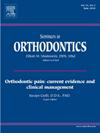Occlusal adjustment in the digital era – A working protocol
IF 2.2
4区 医学
Q2 DENTISTRY, ORAL SURGERY & MEDICINE
引用次数: 0
Abstract
The closest possible coincidence between centric occlusion (CO) and centric relation (CR) is a meaningful goal of orthodontic treatment. Teeth should be related in a cusp-fossa interaction, with bilateral and symmetrical occlusal contacts and mandibular excursions without interferences. At a joint level, condyles should be well-seated in the glenoid fossae, without mandibular functional accommodations and muscular balance. To provide long-term stability of treatment results. Occlusal adjustment is one of the clinical procedures that help fine-tune this resulting occlusal relationship.
Traditional analog diagnostic methods can be upgraded to digital static and dynamic current technologies. Occlusal adjustment today can be integrated with digital flow and mounting by analyzing premature contacts after scanning the patient. The clinical procedure of selective grinding may be simple and reproducible by acquiring adequate knowledge, following the ten guidelines presented in this paper, and implementing judicious clinical skills. Since tooth structure preservation while achieving functional occlusal goals is of utmost importance.
Eight possible clinical scenarios where occlusal adjustment is indicated are presented. They can occur before, during, or after treatment, allowing for a better finish of the orthodontic case. The situations begin with diagnosis, followed by arch coordination, transverse, vertical, sagittal issues, rotations, upper and lower coupling, and relapse.
求助全文
约1分钟内获得全文
求助全文
来源期刊

Seminars in Orthodontics
DENTISTRY, ORAL SURGERY & MEDICINE-
CiteScore
2.20
自引率
4.80%
发文量
28
审稿时长
10 days
期刊介绍:
Each issue provides up-to-date, state-of-the-art information on a single topic in orthodontics. Readers are kept abreast of the latest innovations, research findings, clinical applications and clinical methods. Collection of the issues will provide invaluable reference material for present and future review.
 求助内容:
求助内容: 应助结果提醒方式:
应助结果提醒方式:


